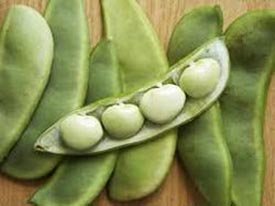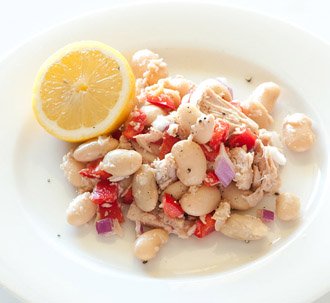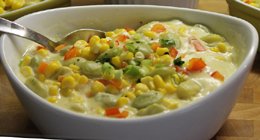Lima beans Nutrition facts
Lima beans are large, flat, off-white, kidney-shaped edible seeds in the bean family. They are usually eaten shelled for their nutritious beans, just like fava beans. In line with other major beans, lima also is one of the ancient cultivated crops.
Lima pods are believed to have originated in the tropical fertile valleys of Central America as wild cultivars and were domesticated by native Mayans, Aztecs, and later by the Incas as a valuable source of protein.
Binomially, lima pod belongs to the Fabaceae family, in the genus: Phaseolus.
Scientific name: Phaseolus lunatus L.
 |
| Lima bean pods. |
Lima beans are perennial, glabrous herbaceous plants that are generally grown as annual crops. There exist two types of seed variations, big and small that evolved from two distinct genetic makeups. Varieties can be grown either as a bush or as a vine (pole) which requires trellising. In general, bush beans yield small seeds often recognized as the sieve or baby lima or butter beans. Whereas vine or pole variants that yield large seeds are categorized as 'lima beans'. While small seeds measure 3 x 2 cm across, large limas can be 4 x 2.5 cm. Either type, however, features a similar buttery texture and sweet flavor.
Bush-type beans generally exhibit smaller and shorter yields in comparison to pole types. Fresh green, "small lima" is ready for harvest in 65-80 days after seedling. "Large lima" takes a little longer and can be harvested in 80-90 days. Harvesting is not time-guided; some farmers prefer collection once the pods grow large enough and sell them as greens in the markets. Others, however, allow the pods to dry on the plant itself for the purpose of procuring dry beans.
Health benefits of Lima beans
Lima beans are important sources of plant proteins. 100 g seeds carry 338 calories and provide 21.46 g or 38% of the daily recommended intake of protein. Also, they are a rich source of antioxidants, vitamins, minerals, and plant sterols.
They, fresh or dried, contain substantial amounts of dietary fiber (50% per 100 g RDA). Dietary fiber functions as a bulk laxative that helps to protect the colon mucosa by decreasing its exposure time to toxic substances as well as by binding to cancer-causing chemicals in the colon. Dietary fiber has also been shown to reduce blood cholesterol levels by decreasing the reabsorption of cholesterol-binding bile acids in the colon.
Unlike in soybeans, lima contain little amounts of isoflavones. Isoflavones such as genistein and daidzein have been found to protect breast cancer in laboratory animals. However, they possess plant sterols (phytosterols) especially ß-sitosterol that help lower cholesterol levels in the body.
Fresh, as well as dry lima, are an excellent source of folates. 100 g dry, mature beans provide 395 µg or 99% of folates. Folate, along with vitamin B-12, is one of the essential co-factor for DNA synthesis and cell division. Adequate folate in the diet around conception and during pregnancy may help prevent neural tube defects in the newborn baby.
Lima (and butter beans) are very rich sources of many B-complex vitamins, especially vitamin-B6 (pyridoxine), thiamin (vitamin B-1), pantothenic acid, riboflavin, and niacin. Most of these vitamins function as co-enzymes in carbohydrate, protein, and fat metabolism.
Furthermore, lima and butter beans are excellent sources of minerals like molybdenum, iron, copper, manganese, calcium, and magnesium. They hold (1724 mg) more potassium than red kidney beans (1,359 mg), broad beans (1,062 mg), and black beans (1483 mg). Potassium is an essential electrolyte of cells and body fluids. It helps counter the pressing effects of sodium on heart and blood pressure. The human body uses manganese as a cofactor for the important antioxidant enzyme, superoxide dismutase.
| Principle | Nutrient Value | Percent of RDA |
|---|---|---|
| Energy | 338 Kcal | 17% |
| Carbohydrates | 63.38 g | 49% |
| Protein | 21.46 g | 38% |
| Total Fat | 0.69 g | 3.5% |
| Cholesterol | 0 mg | 0% |
| Dietary Fiber | 19 g | 50% |
| Vitamins | ||
| Folates | 395 µg | 99% |
| Niacin | 1.537 mg | 9% |
| Pantothenic acid | 1.355 mg | 27.1% |
| Pyridoxine | 0.512 mg | 39% |
| Riboflavin | 0.202 mg | 16% |
| Thiamin | 0.507 mg | 42% |
| Vitamin A | 0 IU | 0% |
| Vitamin C | 0 mg | 0% |
| Vitamin E | 0.72 mg | 5% |
| Vitamin K | 6 µg | 5% |
| Electrolytes | ||
| Sodium | 18 mg | 1% |
| Potassium | 1724 mg | 38% |
| Minerals | ||
| Calcium | 81 mg | 8% |
| Copper | 0.740 µg | 82% |
| Iron | 7.51 mg | 94% |
| Magnesium | 224 mg | 56% |
| Manganese | 1.672 mg | 73% |
| Phosphorus | 385 mg | 55% |
| Selenium | 7.2 µg | 13% |
| Zinc | 2.83 mg | 26% |
| Phyto-nutrients | ||
| Carotene-ß | 0 µg | -- |
| Carotene-α | 0 µg | -- |
| Lutein-zeaxanthin | 0 µg | -- |
Selection and storage
Lima beans come in several forms; fresh, dried, small (baby beans), large, and in a variety of distinctive color patterns. In the US markets, fresh green lima hit the market by July. Fresh-frozen, dried, canned, or roasted beans can also be readily available in stores across the U.S.
While buying fresh lima pods from the local vegetable markets, look for green, mature, plump, and firm pods. You may also purchase fresh or frozen beans from the grocery. Avoid sunken, shriveled pods as the beans convert their sugars into starch. Similarly, dried or canned beans lack sweet flavor as they are deficient in vitamin C and simple sugars. While fresh tender lima beans feature a smooth, pale green color, their color changes to white or cream-yellow once they dry.
Once at home, store unshelled beans in a perforated plastic bag and place them in the refrigerator set at high relative humidity. They stay well for up to a week or so. To enjoy, however, use them soon after the harvest.
Store dry beans in a cool, dry place placed in containers away from high temperatures and high humidity.
Preparation and serving methods
Fresh lima beans are richly flavorful once cooked. As in other beans like edamame, broad (fava), etc., they too have a wonderful “beany” flavor that melts like cream inside the mouth.
Dry lima beans are generally soaked in water for at least 5 hours to make them tender. Soaking also helps remove any anti-nutritional compounds.
 |
| Lima bean tuna salad. Photo courtesy: stone-soup |
To prepare, wash fresh green lima pods in cold running water. Refrigerated beans need to be dipped briefly in room temperature water to help them regain their original flavor.
To shell, snap the calyx end towards the midrib and pull all along the suture line of the pod to remove the string. Split open and remove beans. Drop them into boiling salted water for 1 minute. Drain the water and plunge them into ice water. Beans along with the seed coat can be used in cooking. You may also wish to discard its seed coat (thin cover around the bean), to pop out underlying bright green cotyledons, which are then employed in cooking.
Here are some serving tips:

|
| Succotash. Photo courtesy: Mstwinkie |
Fresh, pale green lima beans are generally treated like vegetables. They are usually used in a wide range of dishes including soups, salads, stir-fries, stews, and casseroles.
They make delicious recipes and mix well with spices, herbs, rice, semolina, peas, carrot, broccoli, chili peppers, onion, tomato, lamb, poultry, and seafood.
Butter beans (small lima) may be added as a replacement to cannellini beans to prepare favorite Tuscan bean soup.
Succotash is a traditional 'Thanksgiving day' dish in New England and Pennsylvania, made using lima beans, corn, peppers, tomatoes and ground beef.
Double beans is the name for shelled lima beans in India, they are a favorite in fries, masalas, stews, and koorma.
Safety profile
Eating raw or sprouted lima beans may cause stomach cramping, diarrhea, and vomiting. Additionally, eating large quantities of undercooked beans releases cyanide (from cyanogenic glucosides), which can impair tissue oxygenation and cause severe illness.
Like in other classes of beans and some brassica group vegetables, lima beans also contain oxalic acid, a naturally occurring substance found in some vegetables, which, may crystallize as oxalate stones in the urinary tract in some people. Therefore, individuals with known oxalate urinary tract stones are advised against eating vegetables belonging to the Brassica and Fabaceae families. Adequate intake of water is encouraged to maintain normal urine output to minimize stone formation risk. (Medical disclaimer)
You may also like to read:-
Adzuki beans nutrition facts and health benefits.
Chickpeas nutrition facts and health benefits.
fava beans nutrition facts and health benefits.
≻≻-Back to Vegetables from Lima Beans nutrition. Visit here for an impressive list of vegetables with complete illustrations of their nutrition facts and health benefits.
≻≻-Back to Home page.
Further Resources:
Stanford School of Medicine Cancer information Page- Nutrition to Reduce Cancer Risk.
UC Davis, Vegetable Research and information center- Phaseolus limensis.-PDF.